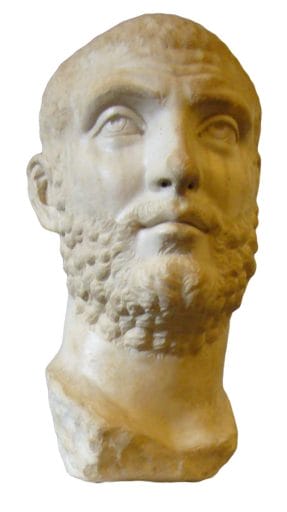Last Updated on December 25, 2021 by Vladimir Vulic
Life: AD c. 250 – 285

- Name: Marcus Aurelius Carinus
- Born AD ca. 250.
- Consul AD 283.
- Became emperor in spring AD 283.
- Wives: (1) Magnia Urbica (one son; Nigrinianus), (2 to 9) unknown.
- Died near Margum, summer AD 285.
Marcus Aurelius Carinus, the elder son of Carus, was born around AD 250. He and his brother Numerian were elevated to the rank of Caesar (junior emperor) in AD 282.
When in December AD 282 or January AD 283 Carus left together with Numerian to campaign first on the Danube and then against the Persians, Carinus was left in Rome to direct the government of the west. It was for this purpose that Carinus was made consul as colleague to his father for 1 January AD 283.
In celebration of his father’s re-conquest of Mesopotamia, Carinus was raised to the rank of Augustus and co-emperor.
It is fairly evident that Carinus was the prefered heir of Carus. He possessed that ruthlessness and military his brother Numerian did not have.
When Carus died later in AD 283, and Numerian took the position of Augustus in the east, there was no opposition and the rule of the joint emperors held the promise of being a reasonably peaceful reign.
Numerian soon initiated moves for a return back to Rome, but died in very mysterious circumstances in Asia Minor (Turkey) in AD 284.
This would have left Carinus sole ruler of the empire, but the late Numerian’s army proclaimed one of their own officers emperor, Diocletian.
Carinus’ reputation as an emperor is among the worst of tyrants. He was a competent ruler and administrator of government, but so too he was a vicious personal tyrant. By marrying and divorcing he accumulated a list of nine wives, some of whom he divorced as they were pregnant. Further to this he appeared to have had a particular liking for affairs with wives of Roman noblemen.
His cruel and vindictive nature saw many innocent men put to death on false charges. He even set out to ruin those of his former pupils at his school who had taunted him, even with trivial banter.
How many of these statements are true is hard to tell, history having largely been written on the basis of propaganda put out by his enemy Diocletian. But it is perhaps fair to say, that Carinus was far from being a model emperor.
Whilst Diocletian arose in the east, Carinus victoriously campaigned against Germans and the Britons (AD 284). But on hearing of Diocletian’s revolt, he could not deal with him at once, as he had a second challenger to his power arise in Marcus Aurelius Julianus, the governor of Venetia, who revolted against him.
Matters are unclear regarding Julianus. He either led a rebellion, based in his own province in northern Italy or he staged a revolt in on the Danube. The place of his demise is also unclear. Either he was defeated early in AD 285 close to Verona in northern Italy, or further east in Illyricum.
With this pretender out of the way Carinus could now deal with Diocletian. He moved up to the Danube where near Margum the two forces finally met.
It was a very hard-fought battle, but eventually it turned in Carinus’ favour.
Victory in his sights, he was suddenly assassinated by one of his own officers, whose wife he had seduced.

Historian Franco Cavazzi dedicated hundreds of hours of his life to creating this website, roman-empire.net as a trove of educational material on this fascinating period of history. His work has been cited in a number of textbooks on the Roman Empire and mentioned on numerous publications such as the New York Times, PBS, The Guardian, and many more.
